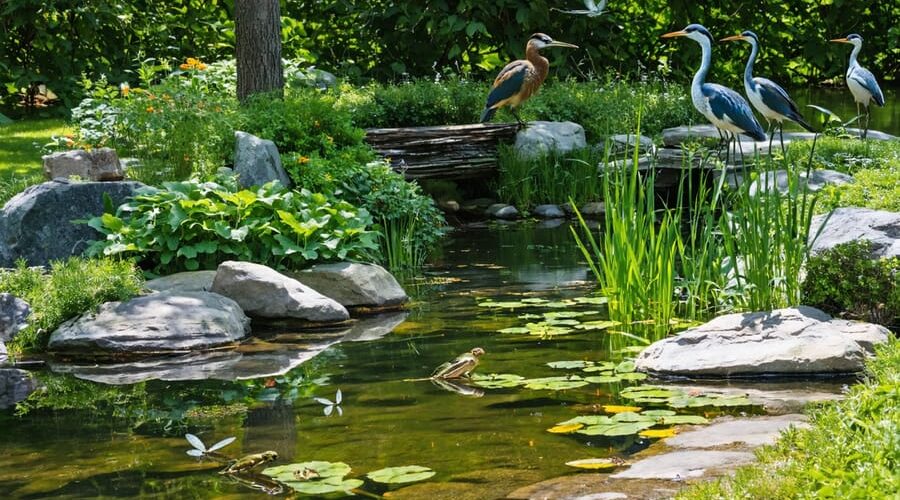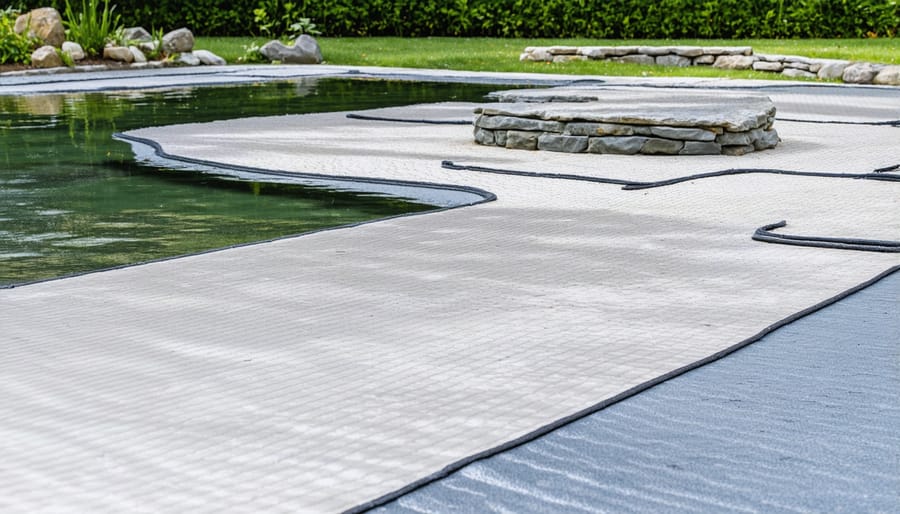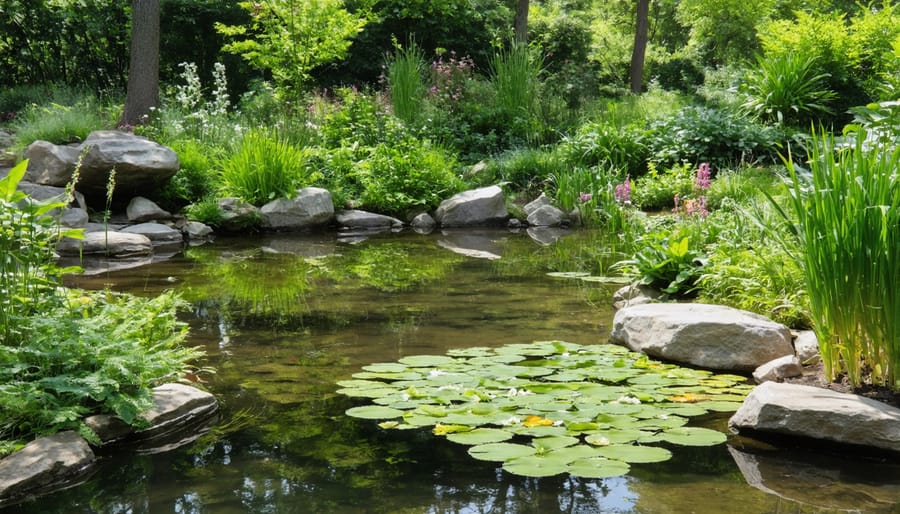
Transform Your Backyard Into a Thriving Wildlife Haven With a Natural Pond
Transform your backyard into a vibrant ecosystem by creating a wildlife pond that attracts dragonflies, frogs, and native birds. The benefits of wildlife ponds extend far beyond their visual appeal, fostering biodiversity and creating natural balance in your garden. Select a partially sunny location away from overhanging trees to prevent excess leaf litter while ensuring varied water depths – from shallow margins for amphibians to deeper zones of at least 60cm for overwintering creatures. Include gently sloping edges with multiple planting shelves to support diverse native aquatic plants, creating essential cover and breeding areas for pond life. Add local stones and logs around the perimeter to create hibernation spots and basking areas, turning your pond into a year-round wildlife sanctuary that naturally maintains its own ecological balance.
Planning Your Wildlife Pond
Choosing the Perfect Location
Selecting the right spot for your wildlife pond is crucial for its long-term success. Aim for a location that receives at least 5-6 hours of sunlight daily, as this helps maintain healthy plant growth and water quality. However, avoid areas with full sun all day, as this can lead to excessive algae growth and water evaporation.
Consider the natural drainage patterns of your garden. Your pond should be positioned away from areas where fertilizers or pesticides might run off during rain. The ideal spot will have slightly sloping ground, allowing excess water to drain away naturally during heavy rainfall without flooding your pond.
Accessibility is another key factor. Choose a location where you can easily maintain the pond and observe wildlife. Ensure there’s enough space around the edges for planting and maintenance work. Keep in mind that you’ll need access to electricity if you’re planning to install a pump or filter system.
Also, avoid placing your pond directly under trees if possible. While some shade is beneficial, falling leaves can overwhelm your pond and affect water quality. If trees are nearby, consider installing a net during autumn to catch falling leaves.
Size and Depth Guidelines
When planning your wildlife pond, size and depth variations are crucial for attracting diverse species. A pond should ideally be at least 2 meters wide at its broadest point, though even smaller ponds can support wildlife. For maximum biodiversity, aim for a total surface area between 2-4 square meters in domestic gardens.
Create different depth zones to accommodate various creatures. Include a shallow marginal shelf (2-3 inches deep) for amphibians and insects, a medium-depth area (12-18 inches) for aquatic plants, and a deep section (24-30 inches) that won’t freeze solid in winter and provides refuge for fish and hibernating frogs.
The pond’s edges should slope gently, creating a beach-like gradient that allows easy access for wildlife. This is particularly important for hedgehogs and other small mammals that might need to escape if they fall in. Incorporate at least one very gradual slope with a ratio of 1:3 (rise:run).
Remember that deeper areas help maintain stable water temperatures and prevent complete freezing, while shallow zones warm up quickly in spring, encouraging early breeding activity among amphibians.

Construction Steps
Excavation and Shaping
Creating a wildlife pond requires careful excavation to ensure it supports a diverse range of creatures. Start by marking out your pond’s shape using a rope or garden hose, avoiding straight lines and perfect circles – nature prefers irregular curves and gentle undulations.
Begin digging from the center, working outward to create distinct depth zones. The deepest area should be around 2-3 feet (60-90cm), which provides essential refuge for wildlife during extreme weather. Create a mid-depth shelf at about 1-2 feet (30-60cm) for marginal plants, and a shallow area that gradually slopes from the edge to about 6 inches (15cm) deep.
When shaping the edges, create gradual beach-like slopes rather than steep drops. This gentle gradient allows animals to easily enter and exit the pond, and provides different habitats for various species. Include some slightly overhanging edges where possible – these offer shelter for small creatures like frogs and newts.
Remember to create stepping levels as you dig, forming natural-looking terraces that will later house different types of aquatic plants. Remove any sharp stones or roots as you go, and ensure the base is level by using a spirit level on a long plank.
Keep the excavated soil nearby – you’ll find it useful for creating wildlife-friendly features around the pond’s perimeter, such as hibernation spots or basking areas for amphibians.
Lining and Protection
Proper lining is crucial for a successful wildlife pond. Start by removing any sharp stones or roots from the excavated area, then lay a protective underlayment across the entire surface. This cushioning layer prevents punctures and extends your liner’s lifespan. Choose a high-quality pond liner made from EPDM rubber or reinforced PVC, ensuring it’s at least 0.75mm thick for durability.
To calculate the liner size, measure the maximum length and width of your pond, then add twice the maximum depth to each measurement, plus an extra 2 feet for anchoring. When laying the liner, work from the center outward, allowing it to settle naturally into the contours. Avoid stretching the material; instead, create neat folds in corners and along slopes.
Secure the edges by digging a small trench around the pond’s perimeter and tucking the excess liner into it. Cover with soil and rocks to hold it in place and create a natural-looking transition. For added protection in rocky areas, consider adding an extra layer of underlayment or carpet padding beneath the main liner.

Edge Treatment
The edges of your wildlife pond are crucial transition zones where land meets water, creating valuable habitat for various creatures. Create gently sloping margins using a combination of different materials to ensure easy access for wildlife. Start with larger rocks and stones at the bottom, gradually transitioning to smaller pebbles and gravel as you move up the slope.
Build in several shallow beach areas with a gradient of 1:3 or gentler, allowing amphibians, hedgehogs, and birds to easily enter and exit the water. These areas also provide perfect basking spots for insects and safe drinking zones for larger animals.
Plant these marginal areas with native species that naturally occur around ponds in your region. Leave some areas of bare ground between plants to create sunbathing spots for dragonflies and damselflies. Consider adding partially submerged logs or large stones that bridge the water and land – these make excellent platforms for frogs and newts.
Remember to include at least one designated exit ramp for any animals that might accidentally fall in. A piece of strong mesh or a wooden plank with good grip, sloping from the deepest part to the edge, works perfectly as a safety ladder.

Plant Selection and Zoning
Marginal Plants
Marginal plants are essential for any wildlife pond, creating crucial transition zones between water and land. These plants thrive in shallow water or damp soil around the pond’s edges, providing shelter for amphibians and insects while adding visual interest to your garden.
Popular marginal plants include Purple Loosestrife, which produces stunning purple flower spikes that attract butterflies and bees. Yellow Flag Iris adds dramatic vertical elements with its sword-like leaves and vibrant yellow blooms. For smaller ponds, consider Marsh Marigold, which offers cheerful yellow flowers in spring and compact growth.
When planting marginals, position them in depths between 0-6 inches of water. Use aquatic baskets filled with aquatic compost to contain vigorous spreaders like Rushes and Sedges. These grass-like plants are excellent for creating natural-looking edges and providing cover for pond wildlife.
Don’t forget about Brooklime and Water Forget-me-not for adding splashes of blue, or Water Mint for its aromatic leaves and wildlife-attracting properties. For autumn interest, Japanese Rush maintains its architectural form throughout the year.
Plant in groups of three or five for natural-looking results, and remember to include plants of varying heights. This creates visual depth and provides different levels of habitat for various pond visitors. Regular maintenance involves removing dead foliage and dividing overcrowded plants every few years to maintain healthy growth.
Oxygenating and Floating Plants
Oxygenating and floating plants are essential pond plants that work together to create a healthy, balanced ecosystem in your wildlife pond. Oxygenating plants, such as hornwort and water milfoil, work beneath the surface to produce oxygen and filter the water naturally. These underwater heroes help prevent algae growth and provide shelter for small aquatic creatures and fish fry.
Floating plants like water lilies and frogbit serve multiple purposes in your pond. Their leaves provide essential shade, helping to regulate water temperature and reduce algae growth by limiting sunlight penetration. They also offer perfect resting spots for frogs and dragonflies, while their underwater portions create safe havens for fish and newts.
For the best results, aim to cover about 50-60% of your pond’s surface with a mix of these plants. Start with at least one oxygenating plant per square meter of pond surface and add 2-3 floating plant species. Remember to choose native species where possible, as these will best support your local wildlife and are typically easier to maintain.
Both plant types work together to maintain crystal-clear water while creating a natural-looking pond that attracts diverse wildlife. As your plants establish themselves, you’ll notice increased activity from beneficial insects, amphibians, and birds visiting your pond.
Attracting and Supporting Wildlife
Creating Microhabitats
A successful wildlife pond needs multiple zones to support different species, and creating diverse microhabitats is key to achieving this. Start by establishing distinct depth zones: a shallow marshy area (2-3 inches deep), a marginal shelf (4-8 inches), and a deeper central area (at least 24 inches). Each zone serves different wildlife needs.
The shallow margins are perfect for amphibians, providing easy access in and out of the pond. Add small stones and logs here to create basking spots for frogs and newts. The marginal shelf is ideal for aquatic plants like rushes and iris, which offer cover for pond inhabitants and perches for dragonflies.
In the deeper zone, include submerged plants like hornwort for fish shelter and underwater sanctuaries. Create mini islands using carefully positioned rocks and logs – these serve as sunbathing spots for birds and insects. Don’t forget to include some overhanging vegetation around the edges, which provides shelter and egg-laying sites for various creatures.
Add different substrate materials like gravel, sand, and larger rocks to create varied textures on the pond bottom. This diversity helps support a wider range of aquatic insects and other small creatures that form the base of your pond’s food chain. Remember to position these features so they create natural corridors, allowing wildlife to move safely between different areas of the pond.
Maintaining Natural Balance
A successful wildlife pond thrives on maintaining ecological balance, which happens naturally when you follow a few simple guidelines. First, resist the urge to stock your pond with fish, as they can disrupt the natural food chain by eating smaller creatures and insects that help keep the ecosystem in check.
Allow native plants to establish themselves gradually, aiming for about 60% plant coverage. This provides shelter for wildlife while leaving enough open water for oxygen exchange. Include a mix of submerged, floating, and marginal plants to create diverse habitats for different species.
Keep maintenance gentle and minimal. Remove fallen leaves in autumn to prevent excess decomposition, but leave some plant debris as it provides valuable habitat for insects and amphibians. Never use chemicals or algaecides – these can harm beneficial organisms and upset the natural balance.
Monitor water quality regularly but don’t panic about slight variations. A healthy pond will self-regulate over time. If you notice algae blooms, consider adding more floating plants to reduce sunlight penetration rather than reaching for quick fixes.
Remember that a wildlife pond is meant to be a little wild. Embrace the natural cycles of life and allow your pond to develop its own character. With patience and minimal intervention, you’ll create a thriving ecosystem that supports local wildlife for years to come.
Creating a wildlife pond is more than just a gardening project – it’s your opportunity to make a real difference to local biodiversity while crafting a stunning natural feature in your outdoor space. By following the guidelines we’ve explored, you’ll be well-equipped to create a thriving aquatic ecosystem that provides a haven for frogs, dragonflies, birds, and countless other fascinating creatures.
Remember the key elements we’ve discussed: choosing the right location, ensuring proper depth variations, selecting appropriate native plants, and maintaining good water quality. Don’t be discouraged if your pond doesn’t burst with wildlife immediately – nature works at its own pace, and your patience will be rewarded as different species gradually discover and colonize their new habitat.
The beauty of a wildlife pond lies in its evolution throughout the seasons, from spring tadpoles to summer damselflies, autumn seed heads to winter ice patterns. Each season brings new wildlife visitors and fresh discoveries to enjoy.
Whether you have a spacious garden or just a small corner to work with, you can create a valuable wildlife habitat that contributes to local conservation efforts. So gather your tools, make your plans, and take that first step toward creating your own piece of wild paradise. The satisfaction of watching your pond develop into a vibrant ecosystem will make all your efforts worthwhile.
